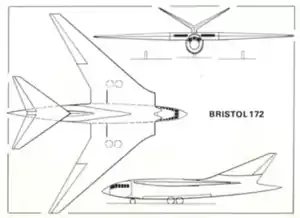Bristol Type 172
The Bristol Type 172 was a 1940s proposed British long range four-engined bomber project. Although work was carried out on designing experimental half-scale variants, none were built and the project was abandoned.
| Type 172 | |
|---|---|
 | |
| Projection drawing[1][2] | |
| Role | Long-range Bomber |
| National origin | United Kingdom |
| Manufacturer | Bristol Aeroplane Company |
| Number built | 0 |
Design and development
In October 1946 the Bristol Aeroplane Company tendered a design to the British Air Ministry for a high-speed long-range bomber with four turbojet engines.[3] Designated Type 172, it was liked by Air Staff, who asked the company to build a smaller half-scale Rolls Royce Nene-powered single-seat aircraft, the Type 174, to the same geometric design with a 45 degree wing sweep.[3]
On 23 July 1947, the Air Ministry issued Specification E.8/47 ("Prototype Flying Models to Operational Requirement 250") to Bristol, who designated it the Type 174.[3][4] After investigation it was found that the high subsonic flow around the wing-body junction would not work, the wing leading edge would need to be swept.[3] In November 1947 work on the Type 174 was stopped and the E.8/47 specification was revised.[3] The revised specification was issued on 8 June 1948 and required a smaller 3/10th scale aircraft powered by a Rolls-Royce Avon engine.[4] Work on the revised design, the Type 176, was started in February 1948.[3] At a subsequent mock-up conference the company felt it could not support further work on the Type 176 as the company needed to concentrate on the Bristol Britannia turboprop airliner.[3]
Variants
- Bristol Type 172
- Proposal for a four-engined long-range bomber, not built.[3]
- Bristol Type 174
- Half-scale variant of the Type 172 for design evaluation powered by a Nene engine, not built.[3]
- Bristol Type 176
- Revised 3/10th Scale development aircraft for the Type 172 powered by a Avon engine, mock-up only, not built.[3]
Specification (Type 172 as proposed)
Data from Barnes[5]
General characteristics
- Crew: 4
- Length: 100 ft (30 m)
- Wingspan: 110 ft (34 m)
- Height: 28 ft (8.5 m)
- Wing area: 2,250 sq ft (209 m2)
- Empty weight: 80,000 lb (36,287 kg)
- Max takeoff weight: 165,000 lb (74,843 kg)
- Powerplant: 4 × Bristol turbojets , 9,000 lbf (40 kN) thrust each
Performance
- Maximum speed: 600 mph (970 km/h, 520 kn)
- Range: 5,400 mi (8,700 km, 4,700 nmi)
- Service ceiling: 50,000 ft (15,000 m)
References
- Notes
- Buttler, Tony (2003). British secret projects : jet bombers since 1949. Hinkley: Midland. pp. 16–17. ISBN 9-781-85-780130-9.
- Porter, Andrew (2013). Transatlantic Betrayal. Amberley Publishing Limited. ISBN 9781445624297.
- Barnes 1988, pp.376-377
- Meekcoms/Morgan 1994, pp. 368-369
- Barnes 1988, p. 382
Bibliography
- C.H. Barnes Bristol Aircraft since 1919, 1988, Putnam, London. ISBN 0 85177 823 2
- Kev Darling. Avro Vulcan, part 1. Lulu.com, 2007. ISBN 9-781-84-799237-6.
- K.J. Meekcom & E.B. Morgan. The British Aircraft Specifications File, 1994, Air-Britain,Tonbridge, Kent. ISBN 0 85130 220 3